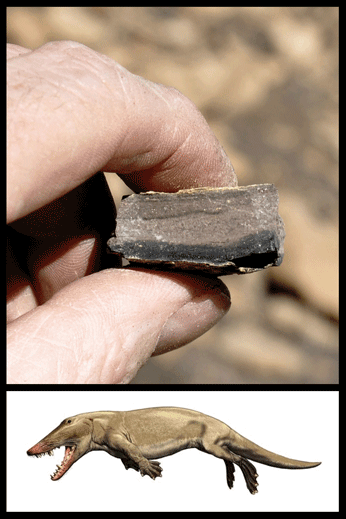
|
K-Pg boundary clay near Trinidad Colorado, enriched with shocked quartz, extraterrestrial iridium, and ash from the worldwide conflagration of forests that accompanied the planet-wrecking asteroid impact.

Ambulocetus, an early whale descended from hoofed ungulates, per Mark John Goodwin, and ten-foot Argentinean Kelenken guillermoi "Terror Bird" per Jack Wood.
|
|
Sixty-five million years later, we have an understanding of how our planet responded to a near knockout-blow.
Centuries of rain cleared the air of soot and debris, and after 10,000 years, steam-shrouded ferns were replaced by palm trees while the Earth absorbed a ten degree (F) warming pulse of CO2. Rodents diversified as new varieties of edible plants appeared, and by 100,000 years the largest weighed about 15 pounds. After a million years, beans, nuts, conifers supported a collection of mammals -- some weighing over 100 lbs.
But avian dinosaurs did not easily surrender the title of crown predator. For many millions of years, North America was stalked by carnivorous ten-foot "Terror Birds" with hooked beaks a foot and a half long. These eventually yielded to mammalian predators resembling bears, lions and dogs.
After 10 million years, dry grasslands favored rhinos, tiny prancing horses, pigs and early elephants. Some hoofed animals even returned to the oceans to morph into dolphins, whales and manatees. This had become "The Age of Mammals."
By the end of the Paleocene, 43 million years after the meteor impact, Earth had undergone an amazing transformation. The placid rivers of Tennessee circled through rich forests filled by day with birdsong and the squeaks of bats by night.
And far away in Africa appeared a new animal with clever hands, binocular vision, and a giant brain.

|